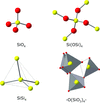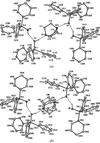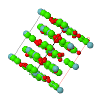issue contents
April 2004 issue

Cover illustration: Crystal packing diagram of 1,4-benzoquinone with Hirshfeld surfaces. The translucent gray surfaces illustrate the nature of these novel surfaces and how they envelop each molecule and reflect the presence of neighbouring molecules. Colours mapped on the central surface represent the distance from the surface to the nearest nucleus in an adjacent molecule: red (shortest), through green, to blue (longest) (McKinnon, Spackman & Mitchell, Acta Cryst. B, in preparation).
research papers


 access
accessX-ray diffraction and high-resolution electron microscopy show that crystallochemical equilibration of calcium–lead fluoro-vanadinite requires annealing at 1073 K for 2 weeks. The approach to equilibrium is controlled by the redistribution of lead ions into the apatite channels which expand to accommodate the larger cation.
















 access
access

 access
accessshort communications




 journal menu
journal menu


































